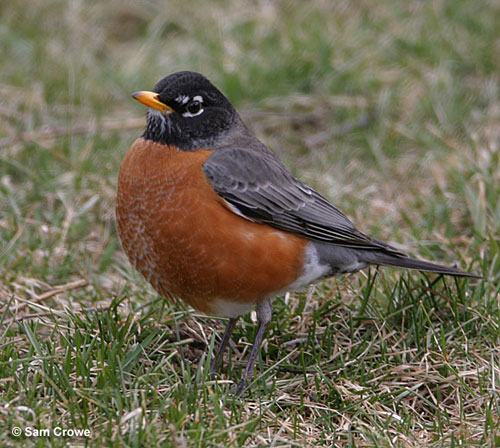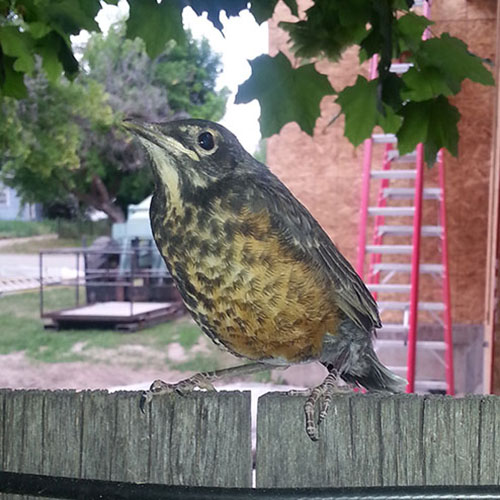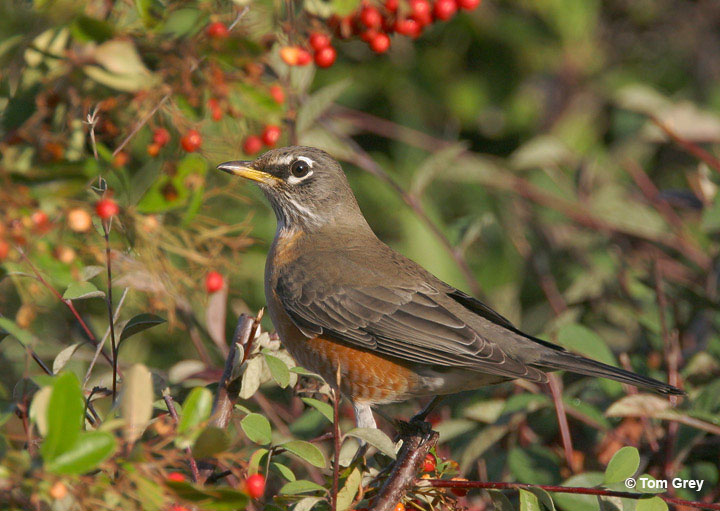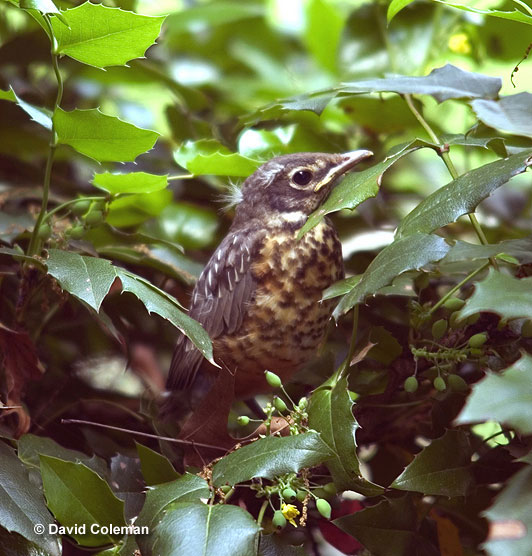
Michigan is a mid-sized state with 99,716 square miles of lakes, rivers, forests, wetlands, and farmlands, and a population of 10,077,331. The Michigan state bird is the American Robin. This familiar thrush charms with its pleasant caroling song and handsome appearance.
This lovely bird has brick-red underparts that contrast with dark gray and blackish upperparts, and an orange-yellow beak. These colors are easy to appreciate as this common and confiding bird forages on lawns and other open habitats.
They also have white markings around their eyes and on the throat. In flight, American Robins show white tips in the corners of their blackish tails.
State Bird
The American Robin was named the official state bird for Michigan on April 8, 1931, following a contest to pick the bird that best represents the state.
As with Connecticut and Wisconsin, the two other states with the American Robin as their state bird, this species was chosen because it is not only a common bird in Michigan, but also familiar, and well-liked bird.
In Michigan, American Robins abound in towns, parks, woodlands, and other habitats throughout the state.

American Robins run along the ground. Other species hop instead of walk.
With its friendly song announcing spring, even non-birders recognize the American Robin and appreciate having this handsome thrush in the backyard.
Although the American Robin is a popular and well-liked bird species, there has been a push to choose a new species for the state bird of Michigan. This new state bird would be the Kirtland’s Warbler, an uncommon species that almost only breeds in Michigan.
In the 1980s, there were only 400 Kirtland’s Warbler left. However, thanks to decades of careful and dedicated conservation work, populations of this small, special bird have grown to more than 4,000.
Naming it as the state bird of Michigan would recognize a conservation success story unique to the state.
Fun Facts about American Robins
- The American Robin is named after a species from a different bird family- When European settlers arrived in North America, the American Robin reminded them of a much smaller bird in the chat family known as the “Robin”. Presently known as the “European Robin”, this chat’s colors and plumage pattern are similar to the American Robin.
- Worms are just one part of the American Robin diet- In fall and winter, this species mostly feeds on berries and fruits.
- American Robins can raise three broods in one season!- These thrushes take advantage of the summer months to have as many babies as possible.
- The American Robin is the largest thrush species in the USA and Canada.
- Not all American Robins migrate- In many places, they simply flock together and spend the winter in parks and in the countryside.
- The oldest American Robin was nearly 14 years old.
- One of the most common birds- According to bird survey data from 2019, American Robins were the most abundant landbird species and have a North American population of 370,000,000.
- American Robins change their songs in urban surroundings- Compared to rural areas, this species sings at a higher frequency in cities. It may do this to be heard over city noise or because of acoustic factors related to concrete and hard surfaces.
Identification
American Robins are fair-sized, plump songbirds. They are 10 inches long, have a 17 inch wingspan, and weigh 2.7 ounces.
This smart-looking bird is an easy one to identify. No other bird within their range looks all that much like them.
Male American Robins are dark gray above, and mostly brick red below with white on their belly. They also have a blackish head with white markings around the eyes and on their throat.
Females are similar but are duller brownish-gray above and paler orange below. They can also show small white markings on their underparts. Young birds look quite different and have dark spots below and more markings on their face.

Young American Robin
Their markings can cause some initial confusion but they still resemble adult American Robins more than any other species.
In flight, American Robins are easily recognized by their orange or brick-red breasts contrasting with a white belly, dark upperparts, and dark tail with small white corners in the outer tail feathers.
What do American Robins eat?
In warm weather, the American Robin eats earthworms, insects, and other small creatures such as snails. They catch these small animals by standing on lawns and other open grassy areas and carefully looking around for prey.
If they spot potential food, they hop closer and quickly snatch it with their beak. If they don’t see anything, the bird picks another spot and keeps looking.

Worms are just one part of the American Robin diet- In fall and winter, this species mostly feeds on berries and fruits. © Tom Grey
In cooler weather, the American Robin mostly feeds on berries and other small fruits. Flocks roam parks and woodlands in search of food. When they find a fruiting bush or tree, they perch in it and pick the fruits with their beaks.
Once in a while, American Robins eat a few too many fermented fruits and become tipsy!
Call
The American Robin often gives a sharp, “yenk!” call and quieter “check” calls repeated two or three times. In flight, when they see a hawk, they also make a high-pitched alarm call, “seet!”.
Read Next: Hawks in Michigan
Although American Robins frequently make these calls, most people are more familiar with their pleasant song. This species sings a beautiful set of caroled phrases, “cheery, cheery, cheery, cheery, cheer, cheer”.
Only males sing this song from trees, rooftops, and other prominent perches. Since American Robins sing in spring and summer, this bird’s song is commonly associated with the arrival of spring.
Behavior
The American Robin is a fairly tame bird accustomed to living around people. They will fly if we approach too close and birds that live in the country are shyer than urban robins but, in general, they aren’t all that afraid of people.
In spring, these classic songbirds are often heard and seen singing from high perches. We also see them foraging for worms and bugs on lawns and other open, grassy habitats.
In late spring and summer, American Robins still forage on open ground. They also start to nest and we can see them carrying food to their young.

By late summer and fall, most have stopped nesting and we see more juvenile birds. This is also when American Robins begin to flock together and although they still feed on the ground, berries become an important part of their diet.
By late fall and winter, American Robins from cold, northern regions have migrated south while birds in other places have formed large flocks that feed on fruiting trees.
These birds are susceptible to predators such as domestic cats, Cooper’s Hawks, Peregrine Falcons, Raccoons, owls, and other animals. They aren’t aggressive around people or pets but will become agitated and give alarm calls if people or animals get too close to their nests and fledglings.
FAQ
What is the state bird of Michigan?
The American Robin is the state bird of Michigan.
Is Michigan changing its state bird?
Not yet. However, some lawmakers are pushing to name the Kirtland’s Warbler the official state bird of Michigan.
Why do so many states have the American Robin as the state bird?
The American Robin is the state bird for Connecticut, Michigan, and Wisconsin because it is a very common, easily seen, handsome bird with a beautiful song.
What is Michigan state flower and animal?
The Apple Blossom is the Michigan state flower. The White-tailed Deer is the Michigan state mammal.
More in Michigan: Most common birds | Hawks | Owls | Woodpeckers | Ducks | Hummingbirds

